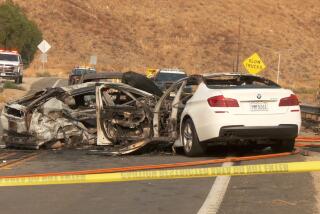Deadliest Known Case of a Tragic Mistake
- Share via
When George Russell Weller told police that Wednesday’s fatal crash at Santa Monica Farmers’ Market may have been caused by stepping on the gas instead of the brake, he described an all-too-familiar scenario known as “unintended acceleration.”
According to scientists and others who study the phenomenon, there have been as many as 10,000 accidents attributed to unintended acceleration nationwide since 1985. Weller’s apparent mistake, however, was the deadliest known case, they said.
“No one has heard of any [such] accident with greater than nine fatalities,” said Tim Hurd, a spokesman for the National Highway Traffic Safety Administration.
Weller’s possible lapse would also have been unusually sustained, lasting for 2 1/2 blocks before his car stopped, said Richard A. Schmidt, a UCLA professor who has studied the subject for more than 15 years.
Unintended acceleration accidents are caused by pedal error, meaning that the driver has stepped on the gas instead of the brake. It is a mistake that statistically is more frequently made by older drivers, Schmidt said. After adjusting for miles driven, drivers 60 to 70 years old are six times more likely to be involved in unintended acceleration accidents than drivers ages 20 to 30, he said, citing his analysis of accident data.
People unfamiliar with the cars they are driving, such as valets, carwash attendants and rental car drivers, also are more likely to make the mistake, he said.
Unlike the 86-year-old Weller, many drivers whose cars suddenly take off blame vehicle malfunction rather than themselves, experts said. Yet, when the vehicles are tested there is generally nothing mechanically wrong, they said.
Highway safety agency spokesman Hurd said his agency has investigated many reports of vehicles suddenly accelerating and almost always attribute the problem to driver error.
In the mid-1980s, for example, owners of automobiles made by Audi complained that the vehicles spontaneously sped away without them stepping on the gas. CBS’ “60 Minutes” ran a story in 1986 saying that Audi’s upscale cars had a tendency to suddenly and dangerously accelerate.
But after investigating the claims of Audi owners, the transportation agency issued a report in 1989 clearing Audi and attributing the problem to driver error.
In years past, most unintended acceleration accidents occurred when drivers started their cars and had their feet on the gas instead of the brake, experts said.
Today, automakers have incorporated shift locks that prevent motorists from putting their cars in gear unless the brake pedal is pressed.
As a result of that safety feature, these types of accidents have declined in recent years.
Schmidt, who wrote a report titled: “Unintended Acceleration: A Review of Human Factors’ Contributions,” said drivers are often preoccupied with some other thought or activity when they make their mistakes.
Schmidt said the public often has a difficult time understanding how such accidents occur, especially when they involve fatalities.
“They ask why didn’t the driver detect the problem, why didn’t they correct it and why did it last so long,” he said.
The answers to those question, according to Schmidt, are complicated but in part center on the driver’s firm but mistaken belief that he has his foot on the brake and not the gas. And once the mistake is made, he said, some people have a tendency to panic, causing them to freeze up.
“These are really life-threatening experiences,” he said. “Not too many of us have had that in our lives. No doubt it’s a frightening ordeal.”






